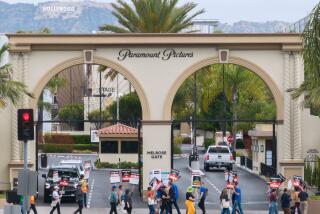Work Stoppage Also Putting a Crimp in Television Commercial Production
- Share via
In addition to shutting down television production, the 21-week-old strike by the Writers Guild of America has had a disruptive effect on the production of commercials and even threatens to put such familiar beasts as Tony the Tiger, Spuds MacKenzie and the Fancy Feast Persian cat on the endangered species list.
With the fall season in jeopardy, fewer television commercials are being made because advertisers can’t be certain whether their spots will appear on new shows or on reruns--or how many people will be watching them.
“Summer is usually one of our busiest seasons, but that certainly isn’t the case this year--production is definitely down,” said Ted Goetz, president the Assn. of Independent Commercial Producers West. “There is a feeling among the producers that the strike is to blame--because of the uncertainty of what the fall TV season will be. Some advertisers are holding back committing production dollars to campaigns until they’re sure of the program it will be shown with.”
“The market for commercials seems to have gotten very quiet,” agreed Bob Kurtz of Kurtz and Friends, one of the country’s top commercial animation studios. “I don’t think it’s had much effect on the people who do ads for sugar cereals and semi-war toys on Saturday mornings, but sophisticated work for an adult, prime-time audience seems to have gotten very slow. We’re not seeing anywhere near the number of properties to bid on that we ordinarily would.”
The slump has affected the commercial market selectively. The producers of spots for what the advertising industry terms package goods-- soaps, toiletries, cleansers, cosmetics and some cereals--have been hit the hardest. Commercials for these items are designed to appeal to the large, general audience that watch prime-time network sitcoms, dramas and mysteries.
Despite the strike and the questions it raises about the number of original programs they will be able to deliver, the networks have reported strong sales of fourth-quarter commercial time. Prime-time ad revenues are expected to break last year’s record total of $3.1 billion. But commercial producers point out that a client who buys advertising time won’t necessarily fill it with new commercials.
“The strike is definitely having an effect on us,” said Jim Kristoff, president of Metrolight, the computer graphics studio that did the new CBS logo. “The advertisers who rely on a mass viewing audience are putting jobs on hold. They bought time with the networks because they have guarantees: If the networks don’t deliver the projected number of households, they have to return the money. But when it comes to spending a lot of money on new productions, they’re holding back and putting old commercials on the air because they’re not sure how many people are looking at them. We need the strike to get over.”
Production on commercials that introduce new product lines, especially cars and trucks, has remained strong. These ads are usually shown during news and sports programs, which are not affected by the strike. And with the presidential election, the World Series and the Olympics scheduled for the fall, the networks have strong lineups in these areas.
“The strike hasn’t really been a problem for us,” said Lee Clow, president and executive creative director of the Los Angeles advertising agency, Chiat/Day. “We’re preparing to introduce a lot of new cars for Nissan. We don’t have a lot of package-goods accounts--the traditional prime-time-type products. I imagine the people who produce commercials to show against generic family programming are having trouble: A client would be apprehensive about putting half a million dollars into a production if there’s no place to run it.”
The Los Angeles ad agency that creates West Coast advertising for Chrysler says it has not yet been hurt by the strike, either. “So far, we haven’t felt a thing,” said Cy Schneider, chairman of Pacific operations for the New York ad firm Bozell, Jacobs, Kenyon & Eckhardt.
But Schneider said there has been somewhat of a slowdown at the agency’s New York headquarters, where some advertisers are “holding off” on creating new ads.
The settlement of the strike probably won’t mean an immediate end to the commercial producers’ problems. Industry observers anticipate a mad scramble for talent and facilities as the studios and networks rush projects into production in an effort to make up for lost time.
“The strike means some talent is available to us that would ordinarily be busy with movies or television shows,” Clow said. “We’re being warned that when the strike ends, everybody will be gobbling up every stage, studio, cameraman, director, etc., in town. We’re getting production done now so that when the strike ends, it won’t be necessary to fight for facilities.”
“Commercial companies are going through very difficult economic times,” Goetz said. “It’s one of the few areas where an advertiser can cut his budget, although production only accounts for 6% to 7% of what a client spends on a television spot. Most of the dollars go into network time, talent, physical things like the tape itself and ad agency commissions. There’s a lot of competition, and the production companies are generally tiny businesses compared to the networks or ad agencies or clients, and it’s easier to squeeze a small business than a big one.”
More to Read
The biggest entertainment stories
Get our big stories about Hollywood, film, television, music, arts, culture and more right in your inbox as soon as they publish.
You may occasionally receive promotional content from the Los Angeles Times.










